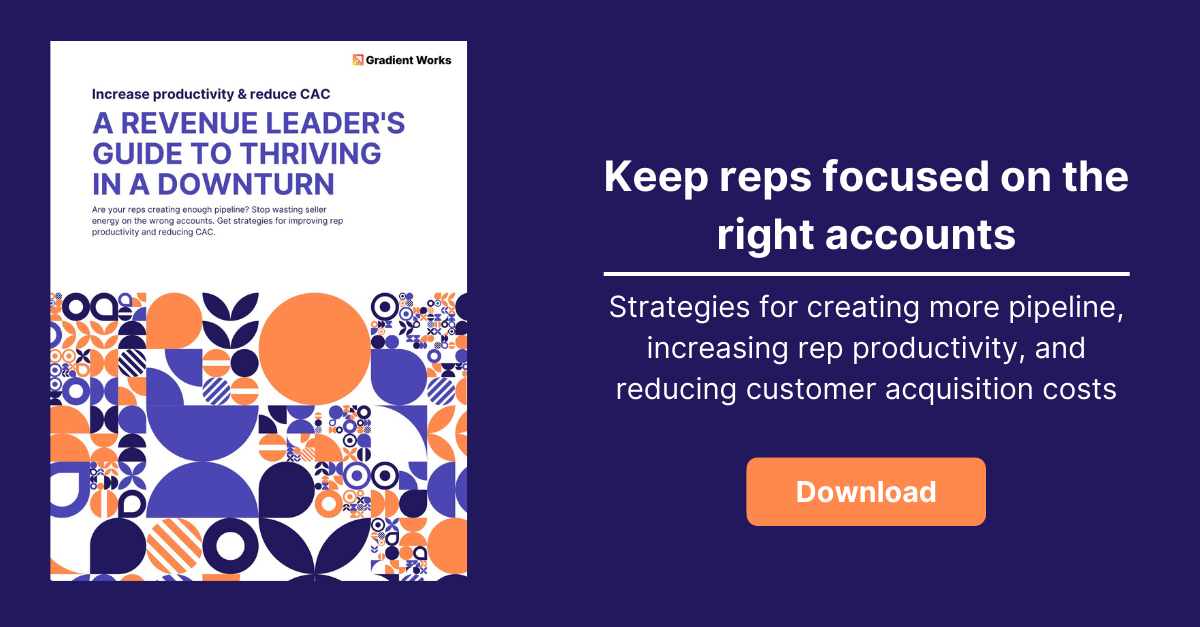You've probably heard a lot of people talking about reducing their customer acquisition cost (CAC) lately. But how can you reduce your CAC, aside from firing your sales team and eliminating your marketing spend (both drastic and probably bad ideas)?
Customer acquisition cost, or CAC, is the total sales and marketing spend required to acquire a new customer. It's a measure of how efficient your GTM motion is.
And right now, when companies everywhere are tightening budgets and reducing headcount, CAC has become a huge topic of conversation. How can we reduce our CAC? And related, how can we reduce our CAC payback period?
The CAC payback period is how long it takes to make back the money you spent acquiring a customer. If you spend $1,000 to acquire a customer, then you want to know how long it takes to make $1,000 back from that customer.
CAC payback calculation and sales efficiency
How do you calculate the CAC payback period? We like this formula from OpenView Partners:
CAC Payback = Sales & Marketing Expenses / (Net New MRR x Gross Margin)
A best-in-class CAC payback period typically is less than a year, even up to 14 months or more. But it varies based on factors like your GTM motion (sales-led or PLG? field sales or inside sales teams? monthly or annual contracts?) and customer type (enterprise? SMB?) and needs to be contextualized alongside your retention metrics.
But regardless of your exact GTM structure, the longer your CAC payback period is, the more brittle your company is right now. It’s time to get ruthless with your CAC payback and improving sales efficiency.
How?
Well, first of all, this post is not going to tell you to do more with less. Instead, it's going to tell you how to do less better. Your mantra should be ruthless execution and focus.
If you're like many companies right now, your board may have already decided to reduce acquisition costs by having fewer sales reps. If you've been through a RIF recently, or even a hiring freeze, you're probably trying to figure out how to hit your number with a smaller team. Even if you haven't had to cut quota capacity yet, you're probably running into other challenges, like longer sales cycles, fewer inbound leads, and so on.
You need to invest in the productivity of your remaining reps because you still need to cover your entire market even with a reduced staff. How efficiently are you using the quota capacity you have?
Here are a few areas to focus on to decrease your CAC calculation.
1. Improve sales rep productivity
It may be time to deploy your reps differently. It starts with enabling your reps with the right offers and the right message, but it goes beyond that.
Right now, your quota capacity is more precious than it's ever been. This isn't the time to spray and pray. Make absolutely sure that your reps are engaging the highest potential accounts - the ones that can commit long-term or the ones with real growth potential. Otherwise, you're wasting everyone's time.
That may include moving from a static territory model to something more responsive to the particular challenges sales teams are facing now. Something like dynamic books, which ensure reps are focused on the best possible accounts at any time.
Other areas to explore to reduce SaaS CAC calculation include:
- Should you strategically apply sales team capacity to your self-service base?
- Should you do more with PLG?
- Do you need to rethink your territory and account allocations?
- What else do your reps need to be focused and productive?
- How can you identify and assign the highest-potential accounts in your database?
Some companies are cutting their SDR teams and moving to a hybrid model where Account Executives are responsible for prospecting and closing new business. If you're doing this, be sure your AEs are equipped with what they need to prospect; some of them might be a little rusty.
If you are keeping an SDR team around, here are some ways to help SDRs increase their outbound opp creation.
This isn't the time to have reps do more activities - more calls and more emails aren't going to magically close more business. Instead, have reps focus on fewer, higher potential accounts. Have them do less better.
2. Understand your ICP and personas
Now's the time to dive deep into your ICP and personas and truly understand your customers. Then focus your efforts on the highest-potential segments.
- What are your most valuable customer segments? What are your worst performing?
- What are your customers' and prospects' main challenges right now? Does that change the messaging you use in outreach?
- How can you focus your GTM efforts differently? Can you be more targeted, more specific?
- Are there segments that are currently underserved where you could expand?
The more you know about your customers and their current challenges, the better equipped you'll be to provide what they need now.
3. Find more growth in your existing customer base
When new business slows down, like it is now, NRR becomes more important than ever. Focus on your existing customers and find ways to expand that business.
- Can you upsell or cross-sell? Are there new use cases you could support?
- Can you renew early and lock in longer contracts?
- Are your happiest customers as happy as they could be?
- Who's in danger of churning next quarter?
If you want more ideas about increasing NRR, read this.
What other ways are you trying to reduce your customer acquisition costs and payback period?





